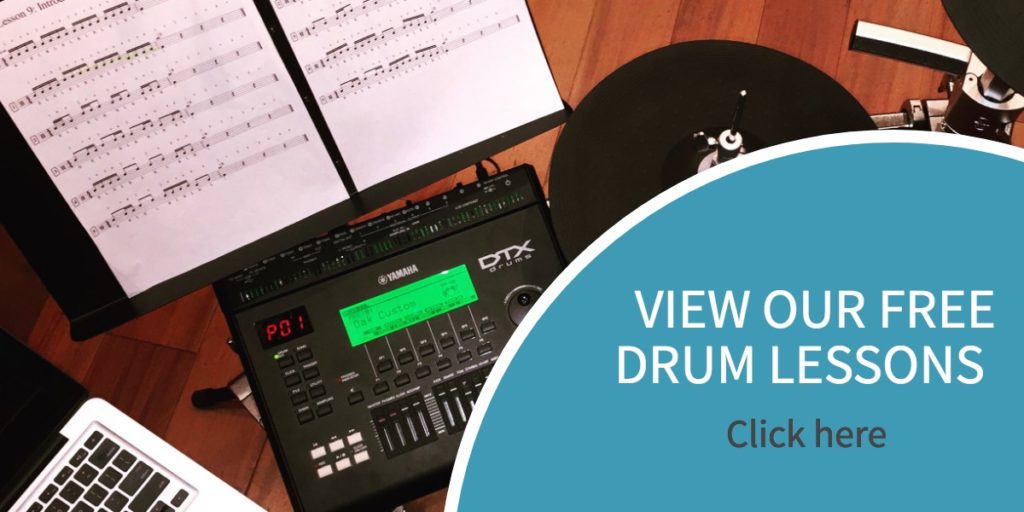Do you obsess about playing a drum part exactly as it was recorded? Are you struggling to play a drum part because it’s too technical or too fast? If the answer to either of these questions is “yes”, then you might want to spend five minutes reading this article.
Simplification is a word that comes up in my drum studio every day without exception. You can apply the simplification approach to just about every aspect of your drumming, from beats and fills to playing along with songs, to the actual set up that you choose. Simplification should not be seen as a short cut. It can be used as a stepping stone to a specific defined goal, or it can be a choice – an accepted, and often necessary compromise.
Helpful related articles.
10 bad drumming habits and how to fix them.
How do I drum faster? Why speed is a byproduct of control.
Nothing takes the fun out of playing along to your favorite song then the realization that the part may be too technical to play. This is a very common scenario for the majority of beginner drummers as naturally, you are still honing your fundamentals. When this happens, there are generally three options available. Firstly, you can choose a different song. Secondly, you can, over time, work on the parts that are the most challenging. Thirdly, you can simplify the part and start playing right away.
As option one is always a little disappointing, my recommendation is a combination of options two and three. There are normally three problem areas that may require a simplified approach – the main beat, a drum fill (or multiple fills), or the actual speed of the song.
“Nice job on the groove, but I think you might be missing the “A” of the 2 on the bass drum.”
No one ever.
The Beat.
I recently had a student who wanted to play the track Sweet Home Alabama. Just one sixteenth note on the bass drum line (The “A” of the 2, for those of you who understand the reading, and know the song) was preventing her from playing the verse beautifully at the song tempo of 98bpm. By simplifying the part, and thus removing the offending 16th note, we were able to come up with a perfectly playable, and musically acceptable part. As I explained to my student, no one is gong to come up to you and say “Nice job on the groove, but I think you might be missing the A of the 2 on the bass drum.” As long as the main back beat is there, the finer nuances can always be worked out and added at a later date. We also came up with a plan to play the actual beat, true to the original recording, at 55bpm. Over a few weeks, by increasing this starting point by 5bpm each time, she eventually reached the goal of 98bpm and could play the beat comfortably. Speed is always a byproduct of control, as this article emphasizes.
If you are struggling with a beat, take a moment and identify what parts of that beat are absolutely essential. Then think about what you could do without. At this point, you are on your way to simplifying a part, and having a lot more fun and less frustration. Come up with a plan to work on the part as originally recorded starting at slower tempos. Manage your expectations and commit practice time to this task.
Drum Fills.
The same approach can be used when approaching drum fills. I always encourage students to play their own variation of a fill, rather then obsess about the way the part was originally played. You might be playing a Foo Fighters song, but Taylor Hawkins is not in the hot seat – you are! Taylor Hawkins has been playing for decades, and this is a new experience for you, so it is important and necessary to manage your expectations. Again, if you formulate a plan to work on the fill that is challenging you, over time you will get where you want to be. Start slowly, and think about the sticking. In the meantime, adding your own fill is more fun, and will facilitate you being able to play the song sooner. I would say that one exception to this approach is the “iconic drum fill”. For example, if you are playing “In The Air Tonight” by Phil Collins, there’s a lot to be said for nailing that iconic drum fill. Yes, that one. (Start slow, and build up speed over time as we have discussed). 99% of songs however, do not have iconic fills. They may be tasteful, musical, or technically proficient – but when all is said and done, they are mostly just fills.
Speed.
Most drum students, and many experienced drummers for that matter, can struggle to keep up with songs that may have higher tempos. The issue is not exclusively the speed of the song, but the technique that is required to play musically, efficiently and comfortably at higher speeds. As a beginner drummer, you are still honing these skills, and this article can help you understand how to approach the challenge of speed. One common solution is to simplify the beat. If the beat is too fast in 8th notes, then try playing it in 1/4 notes. If the beat is too fast in 16th notes, try playing it in 8th notes. You need to have a basic understanding of music notation to comprehend this – our music notation videos explain everything in methodical and easy to understand steps. While you are having fun playing your simplified beat, you should have a plan in your practice routine to work on the beat as played on the recording, at slower tempos, working with a metronome, and increasing in small increments as you make progress.
Learning the drums should be fun, and playing along to music is a milestone for beginner drummers. If you are finding working on a song frustrating, try simplifying. Working with a drum teacher is always a good idea, and if you are not a Drum Ambition subscriber, then check out our curriculum. We specialize in simplifying the experience without taking short-cuts, and fine tuning the important fundamentals.
If you have any questions relating to this article, please feel free to email support@drumambition.com.
Simon DasGupta.


